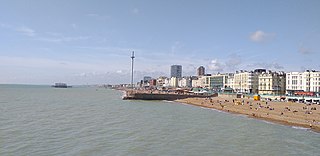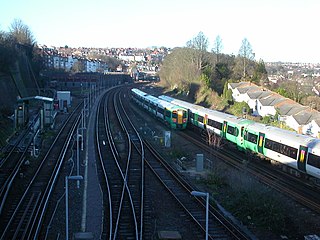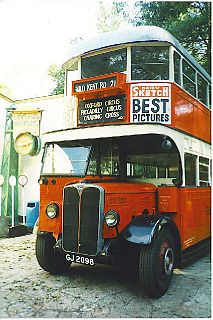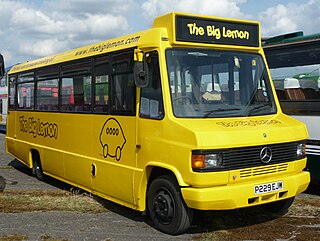Related Research Articles

Brighton is a constituent part of the city of Brighton and Hove, a former town situated on the southern coast of England, in the county of East Sussex. It is best known as a seaside resort and is positioned 47 miles (76 km) south of London. It was created from the neighbouring but formerly separately governed towns of Brighton and Hove.

The London Bus is a London transportation system used for multiple decades. Considered to be an icon of London, the London Bus operates by day and night on many different routes and lines. The main image of a London Bus is an arched, double-decker, red-painted bus which can carry a large number of passengers.

Brighton railway station is the southern terminus of the Brighton main line in England, and the principal station serving the city of Brighton, East Sussex. It is 50 miles 49 chains (81.45 km) from London Bridge via Redhill.
The Go-Ahead Group plc is a passenger transport based in Newcastle upon Tyne, England. It has operations in the United Kingdom, Ireland, Singapore, Norway and Germany. It is listed on the London Stock Exchange.

The West Coastway line is a railway line in England following closely the south coast of Sussex and Hampshire, between the cities of Brighton and Southampton. It has short southward branches to Littlehampton and Bognor Regis. Some trains using part of the route operate as direct continuations of passenger services to/from London, particularly those to the branch stations mentioned.

Brighton & Hove operates most bus services in the city of Brighton and Hove in southern England. It is a subsidiary of the Go-Ahead Group.
Tilling-Stevens was a British manufacturer of buses and other commercial vehicles, based in Maidstone, Kent. Originally established in 1897, it became a specialist in petrol-electric vehicles. It continued as an independent manufacturer until 1950, when it was acquired by the Rootes Group.

Hangleton is a residential suburb of Hove, part of the English city and coastal resort of Brighton and Hove. The area was developed in the 1930s after it was incorporated into the borough of Hove, but has ancient origins: its parish church was founded in the 11th century and retains 12th-century fabric, and the medieval manor house is Hove's oldest secular building. The village became depopulated in the medieval era and the church fell into ruins, and the population in the isolated hilltop parish only reached 100 in the early 20th century; but rapid 20th-century development resulted in more than 6,000 people living in Hangleton in 1951 and over 9,000 in 1961. By 2013 the population exceeded 14,000.

Public transport in Brighton and Hove, a city on the south coast of England, dates back to 1840. Brighton and Hove has a major railway station, an extensive bus service, many taxis, coach services, and it has previously had trolley buses, ferries, trams, auto rickshaws and hydrofoils.

Southdown Motors Services Ltd was a bus and coach operator in East and West Sussex and parts of Hampshire, in southern England. It was formed in 1915 and had various owners throughout its history, being purchased by the National Bus Company (NBC) in 1969. The company fleet name was lost when it was acquired by the Stagecoach Group in 1989 but buses operated under that legal name until 2015 when the operating licence was transferred to another company within the Stagecoach Group and 1915 company became dormant but still owned by the Stagecoach Group.

Bristol Commercial Vehicles was a vehicle manufacturer located in Bristol, England. Most production was of buses but trucks and railbus chassis were also built.

Tuctuc Ltd was an auto rickshaw operator in Brighton, England. It operated for just over a year from the summer of 2006 until late 2007, but opposition from taxi operators and licence breaches "made the service unworkable" and the vehicles were withdrawn. In 2009 they were used again for weekend sightseeing tours of the city.

A battery electric bus is an electric bus that is driven by an electric motor and obtains energy from on-board batteries. Many trolleybuses use batteries as an auxiliary or emergency power source.

The Brighton Belle was a named train which was operated by the Southern Railway and subsequently by British Rail from Victoria Station in London to Brighton, on the Sussex coast. Commissioned as the flagship of the Southern Railway's mass electrification project, which commenced in January 1931, the world's only electric all-Pullman service ran daily between London Victoria and Brighton from 1 January 1933 until 30 April 1972.

Thomas Tilling Ltd, later known with its subsidiary companies as the Tilling Group, was one of two conglomerates that controlled almost all of the major bus operators in the United Kingdom between World Wars I and II and until nationalisation in 1948.

Buses play a major role in the public transport of the United Kingdom, as well as seeing extensive private use. While rail transport has increased over the past twenty years due to road congestion, the same does not apply to buses, which have generally been used less, apart from in London where their use has increased significantly. Bus transport is heavily subsidised, with subsidy accounting for around 45 per cent of operator revenue, especially in London.

The Big Lemon is a bus and coach operator in Brighton, East Sussex. It is registered as a Community Interest Company.
Worthing, a seaside town with borough status in the United Kingdom, is connected to the rest of the country by a network of major roads, a mainline railway, frequent bus and coach services and a nearby airport. Its 19th-century growth was encouraged by the development of turnpikes and stagecoach routes to London and nearby towns. By the middle of that century railway services improved journey times and conditions significantly. Suburbanisation in the 20th century was assisted by a network of bus routes.
The Brighton and Shoreham Tramway operated a tramway service in Shoreham between 1884 and 1913.

The Worthing Tramocars formed part of the public transport network in Worthing, a seaside resort in West Sussex, England, during the 1920s and 1930s. The vehicles were converted dustbin lorries manufactured by Shelvoke and Drewry and adapted for use by elderly people. "The service was the brainchild" of Bill W. R. Gates, a businessman who had made his fortune in New Zealand before returning to his native England. He registered the name Tramocar as a trademark and procured and converted 13 vehicles for use on various routes around the town. Tramocar services ran from 1924 until 1942—latterly operated by bus company Southdown Motor Services, which introduced a further two Tramocars—but a replica vehicle is still operational at a museum in West Sussex.
References
- ↑ "London Electrobus Co - Graces Guide". www.gracesguide.co.uk. Retrieved 11 November 2017.
- ↑ "All Aboard". New Scientist: 35–37. 9 September 2017.
- ↑ "What is this that roareth thus". The Economist Technology Quarterly: 9. 8 September 2007.
- ↑ Google Books - New Scientist, 17 July 1986
- 1 2 The Fraud that Killed Off London’s First Electric Buses - Ian Mansfield, 9 January 2014
- ↑ Georgano, Nick (1996). Electric Vehicles. Shire Publications. pp. 20–21. ISBN 9780747803164.
- ↑ "Our Fortnightly Census". Commercial Motor: 336. 31 December 1908.
- 1 2 Hamer, Mick (2017). A Most Deliberate Swindle. London: RedDoor. pp. 171, 197. ISBN 9781910453421.
- ↑ Kaye, David (1976). British Battery Electric Buses. The Oakwood Press. p. 8.
- ↑ "Brighton and Hove Buses company history".
| This London-related article is a stub. You can help Wikipedia by expanding it. |
| This article about a company of the UK is a stub. You can help Wikipedia by expanding it. |
| This environment-related article is a stub. You can help Wikipedia by expanding it. |




